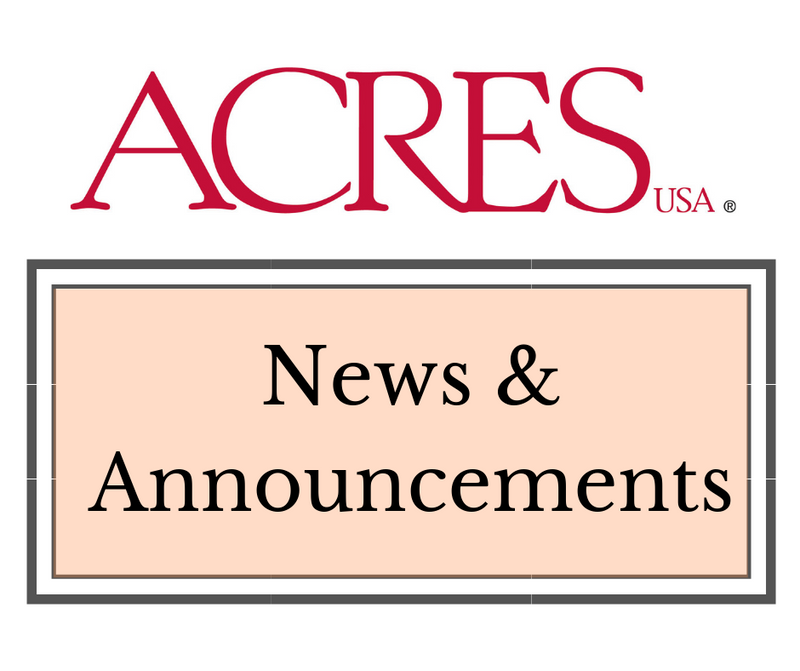 For the Acres U.S.A. team, December is one of our busiest and most anticipated months of the year. It means seeing our friends and colleagues at our annual Eco-Ag Conference & Trade Show; providing extra customer service and shipping care to customers ordering books, subscriptions, gift cards and other Acres U.S.A. products as holiday gifts; and creating our largest issue of the year!
For the Acres U.S.A. team, December is one of our busiest and most anticipated months of the year. It means seeing our friends and colleagues at our annual Eco-Ag Conference & Trade Show; providing extra customer service and shipping care to customers ordering books, subscriptions, gift cards and other Acres U.S.A. products as holiday gifts; and creating our largest issue of the year!
We know you will enjoy all the articles from our December 2018 issue. You’ll find:
- features by Leilani Zimmer Durand & Gary Zimmer on building the microbial bridge to support nutrient availability for plants;
- the first article in a series focused on the history of organic agriculture in America and those who played a role in shaping the movement;
- the inner workings of Green Field Farms and secrets to co-op success by Wayne Wengerd;
- understanding proline and plant stress by Dr. Larry Zibilske, growing organic hazelnuts in Oregon;
- an in-depth Q&A with North Dakota regenerative farmer Gabe Brown by Tracy Frisch who visited Brown’s Ranch this summer.
We’ve also included articles on native pecan production, the growing trend of tool lending libraries, an inspiring essay on finding purpose and renewal in eco-farming, and much more.
Don’t miss Chris Walters’ in-depth interview with researcher and author Fred Provenza who recently completed Nourishment: What Animals Can Teach Us about Rediscovering Our Nutritional Wisdom. Provenza discusses animal and human nutrition as linked to ecological, economic and social systems.
Here’s an excerpt of the interview:
Endless Transformation
Researcher, Author Fred Provenza Discusses Animal, Human Nutrition as Linked to Ecological, Economic & Social Systems Across the Globe
ACRES U.S.A. One of your opening salvos is about how animals know what to eat and where to eat it and when not to eat it. Except that they can sometimes make a mistake, eat the wrong plant, and die. How did animal behavior lead you to studying the wisdom of the body, another of your main themes?
PROVENZA. All that started back in the years when I was working on a ranch in Colorado. I spent seven years there during my latter days of high school, then through college, and then a couple years after that, simply observing what animals did. I was fascinated by plants. I was fascinated by domestic and wild animals. Why do they do what they do? Why do they eat what they eat, go where they go? When I started doing research in southern Utah, watching goats eat, I noticed that goats would not eat the parts of plants that we thought were most nutritious. It hugely piqued my interest. Throughout all that time, I believed that they knew what they were doing, that there is a wisdom. Back in the day, people in agriculture didn’t put much stock in that. Today that’s probably not as true, because of our work and work that others have done. We observed what animals did and then tried to figure out why they were doing that. Why don’t goats eat new twigs on blackbrush, which looks to be the most nutritious thing? Well, come to find out, there’s nasty compounds in there, and the goats were several steps ahead of what classical nutrition would have said just by doing laboratory analysis. The goats knew what was best for them at that point. All of that led into 30 years of research.
ACRES U.S.A. From small things big things one day come?
PROVENZA. We were just trying to look at three facets really — food selection, nutrition and health for livestock. That’s what I compare and contrast with human food selection, nutrition and health throughout the book. But those three facets are one of these feedbacks that occur at the cellular level. The feedbacks that are in response to the primary and secondary compounds in plants. There is all this complex chemistry, and animals are responding at a cellular level and up through organ systems, including the microbiome, which everyone is so interested in nowadays. All those systems are responding. There’s this basic notion of feedback that I talk about a lot in the book. And then that gets linked with the availability of alternative. Now feedback is a critical part of nutrition wisdom of the body, but if you don’t have decent alternatives, there’s no way you can meet needs for nutrients and self-medicate. You have to have decent choices, which is the second leg of this stool. The third leg is culture.
You can download this issue for $6.00.
Share:

0 comments